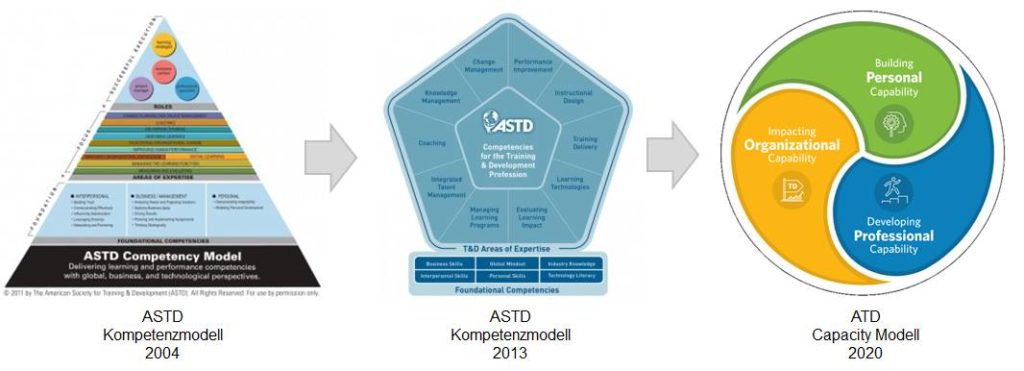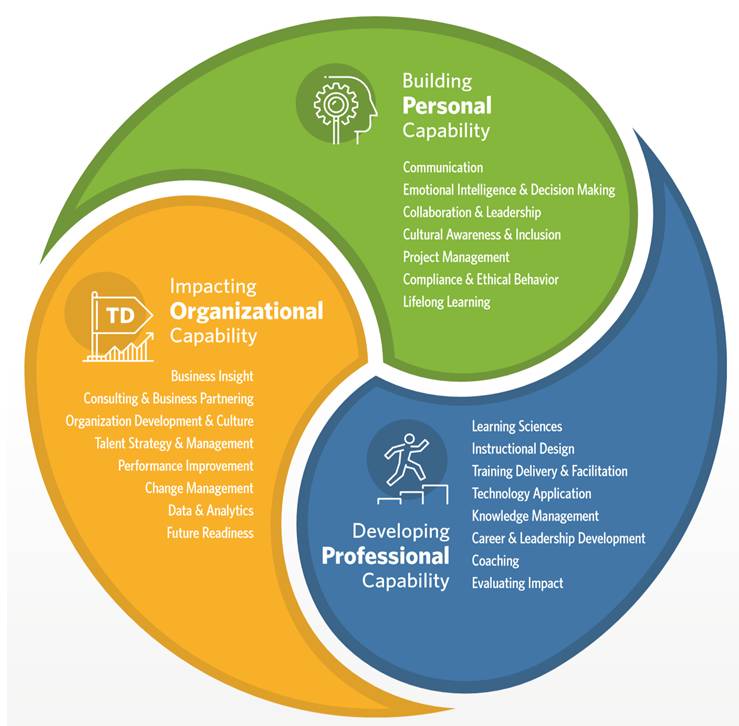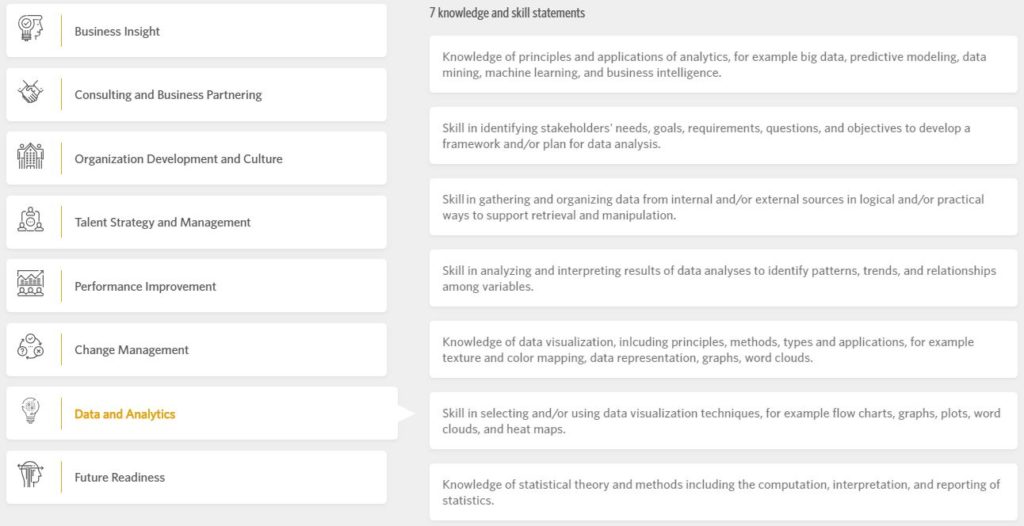Die Association for Talent Development (ATD) hat ein neues Capability-Modell für Talent Development Professionals publiziert. Neu stehen drei Bereiche im Vordergrund: “building PERSONAL capability”, “developing PROFESSIONAL capability” und “impacting ORGANIZATIONAL capability”.
Seit 1978 entwickelt die ATD (vormals ASTD) Kompetenzmodelle für Learning Professionals (vgl. die kurze Übersicht am Ende dieses Artikels). Diese Kompetenzmodelle sind unter anderem auch die Grundlage der von ATD angeboten Weiterbildungen und Zertifizierungen.
Im Pyramiden-Modell von 2004 werden verschiedene Rollen für Personalentwickler einerseits (z.B. “learning strategist” oder “business partner”) und Basiskompetenzen (z.B. “Bedarfsanalysen durchführen und Lösungsansätze entwickeln”) sowie Vertiefungsbereiche (z.B. “Wissensmanagement”) unterschieden. Mit dem Kompetenzmodell von 2013 wurde einerseits die Orientierung an klar abgrenzbaren Rollen aufgegeben und zum anderen wurden die Kompetenzbereiche weniger hierarchisch strukturiert. Mehr dazu in diesem Blogpost von scil. Im aktuellen Heft des td Magazins (Februar 2020) wird nun wiederum eine neue Version des Kompetenzmodells vorgestellt. In diesem Modell stehen drei ineinander greifende Bereiche im Vordergrund:
- “building PERSONAL capability”,
- “developing PROFESSIONAL capability” und
- “impacting ORGANIZATIONAL capability”:

Bildquelle: ATD / scil
Die Überarbeitung des Modells beruht auf Literaturstudien, Interviews mit Praktikern und Diskussionen in Fachgruppen der ATD. Die veränderte visuelle Darstellung ist Ausdruck konzeptioneller Veränderungen. Die deutlichste ist wohl, dass nicht mehr wie bisher von Kompetenzen, sondern neu von Fähigkeiten (capabilities) gesprochen wird. Im Beitrag des td-Magazins wird dies wie folgt begründet:
Competence has become a somewhat outdated and passive term. It refers to a person’s current state and to them having the knowledge and skills necessary to perform a job. Capability is about integrating knowledge and skills and adapting and flexing to meet future needs. By shifting from a competency model to a capability model, ATD is helping TD professionals put their knowledge and skills to work to create, innovate, lead, manage change, and demonstrate impact.
Morgan Hirt, td magazine, 02/2020
Ich bin nicht sicher, inwiefern diese Begründung auch im deutschen Sprachraum überzeugt, da hier ja bereits seit längerem handlungs- und problemlösungsorientierte Verständnisse von Kompetenz (z.B. Euler / Hahn, Erpenbeck) etabliert sind. Aber dies nur am Rande…
Das aktuelle Modell umfasst also drei Handlungsfelder mit 23 Fähigkeiten und insgesamt 189 Aussagen zu Wissen und Fertigkeiten. Die drei Handlungsfelder werden wie folgt formuliert:
- Building PERSONAL capability:
“This domain of practice embodies the foundational or enabling abilities all working professionals should possess to be effective in the business world. These largely interpersonal skills (…) are needed to build effective organizational or team culture, trust, and engagement.”
(communication, emotional intelligence, collaboration, cultural awareness, etc.) - Developing PROFESSIONAL capability:
“This domain of practice embodies the knowledge and skills talent development professionals should possess to be effective in their roles of creating the processes, systems, and frameworks that foster learning, maximize individual performance, and develop the capacity and potential of employees.”
(instructional design, training delivery & facilitation, knowledge management, technology application, etc.) - Impacting ORANIZATIONAL capability
“This domain of practice embodies the knowledge, skills, and abilities needed by professionals to ensure talent development is a primary mechanism driving organizational performance, productivity, and operational results.” (business insight, consulting, organizational development & culture, data & analytics, etc.)

Bildquelle ATD
Auf einer nächsten Ebene werden dann die einzelnen Fähgikeiten (capabilities) anhand von weiteren Aussagen spezifiziert. Die folgende Abbildung zeigt dies am Beispiel der Fähigkeit “Data & Analytics”, die neu in das Modell integriert wurde:

Bildquelle ATD
Über die einzelnen “knowledge and skill statements” könnte man vermutlich noch viel diskutieren. Für mich stellt sich beispielsweise die Frage, ob die unter PROFESSIONAL capability / Technology application angeführte Aussage zu Wissen und Fertigkeiten ausgewogen ist:
Skill in developing artificial intelligence, machine learning algorithms, augmented reality, and mixed reality that are ethical and free of bias.
ATD Capability Model
Die Entwicklung von AR- bzw. XR-basierten Lernumgebungen bzw. Lernressourcen kann ich gut als Aufgabe für Learning Professionals sehen, die Entwicklung von KI und Algorithmen eher weniger (wohl aber deren Anwendung im Lernkontext).
Die Entwicklungsfelder und die zugehörigen Fähigkeiten sind in diesem Dokument ausführlicher beschrieben. Über diese Webseite können die einzelnen Entwicklungsfelder, die zugeordneten Fähigkeiten und die Aussagen zu Wissen und Fertigkeiten erkundet werden.
In der gleichen Ausgabe des td-Magazins kommentiert der ehemalige Gründer der Motorola University John Coné das Modell und stellt dabei seine grosse Flexibilität heraus:
When ATD produced the 2013 model, organizations were just beginning to experience the impact of the digital transformation. (…) We are in an era of ever-growing information availability, accelerating search capability, analytics, and artificial intelligence. Thus, ATD’s model must remain robust in the face of the continuous disruption of society, business, HR, and TD. (…) the Capability Model (…) offers structure and makes clear the capabilities critical to our profession—and it represents an almost infinite number of combinations that can create totally unique profiles. (…) ATD’s new model contains the capabilities that enable TD professionals to do what they’ve done for decades and that those they serve still need. But it also prepares them to do some of those things in new ways and to do some different things.
John Coné, td magazine, 02/2020
[…] in denen sich ihre Zielgruppen bewegen? Darauf habe ich (noch) keine Antwort gefunden …Christoph Meier, scil-blog, 15. Februar 2020 […]